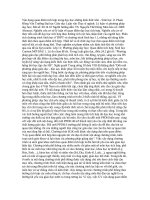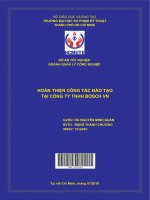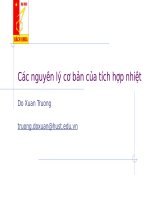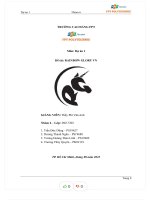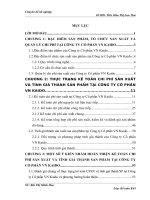a0060 oreilly introducing regular expressions jul 201 morebook vn 2035 2
Bạn đang xem bản rút gọn của tài liệu. Xem và tải ngay bản đầy đủ của tài liệu tại đây (5.08 MB, 7 trang )
Download from Wow! eBook <www.wowebook.com>
Introducing Regular Expressions
Michael Fitzgerald
Beijing • Cambridge • Farnham • Köln • Sebastopol • Tokyo
Introducing Regular Expressions
by Michael Fitzgerald
Copyright © 2012 Michael Fitzgerald. All rights reserved.
Printed in the United States of America.
Published by O’Reilly Media, Inc., 1005 Gravenstein Highway North, Sebastopol, CA 95472.
O’Reilly books may be purchased for educational, business, or sales promotional use. Online editions
are also available for most titles (). For more information, contact our
corporate/institutional sales department: 800-998-9938 or
Editor: Simon St. Laurent
Production Editor: Holly Bauer
Proofreader: Julie Van Keuren
July 2012:
Indexer: Lucie Haskins
Cover Designer: Karen Montgomery
Interior Designer: David Futato
Illustrator: Rebecca Demarest
First Edition.
Revision History for the First Edition:
2012-07-10
First release
See for release details.
Nutshell Handbook, the Nutshell Handbook logo, and the O’Reilly logo are registered trademarks of
O’Reilly Media, Inc. Introducing Regular Expressions, the image of a fruit bat, and related trade dress
are trademarks of O’Reilly Media, Inc.
Many of the designations used by manufacturers and sellers to distinguish their products are claimed as
trademarks. Where those designations appear in this book, and O’Reilly Media, Inc., was aware of a
trademark claim, the designations have been printed in caps or initial caps.
While every precaution has been taken in the preparation of this book, the publisher and authors assume
no responsibility for errors or omissions, or for damages resulting from the use of the information contained herein.
ISBN: 978-1-449-39268-0
[LSI]
1341860829
Table of Contents
Preface . . . . . . . . . . . . . . . . . . . . . . . . . . . . . . . . . . . . . . . . . . . . . . . . . . . . . . . . . . . . . . . . . . . . . vii
1. What Is a Regular Expression? . . . . . . . . . . . . . . . . . . . . . . . . . . . . . . . . . . . . . . . . . . . . . 1
Getting Started with Regexpal
Matching a North American Phone Number
Matching Digits with a Character Class
Using a Character Shorthand
Matching Any Character
Capturing Groups and Back References
Using Quantifiers
Quoting Literals
A Sample of Applications
What You Learned in Chapter 1
Technical Notes
2
2
4
5
5
6
6
8
9
11
11
2. Simple Pattern Matching . . . . . . . . . . . . . . . . . . . . . . . . . . . . . . . . . . . . . . . . . . . . . . . . 13
Matching String Literals
Matching Digits
Matching Non-Digits
Matching Word and Non-Word Characters
Matching Whitespace
Matching Any Character, Once Again
Marking Up the Text
Using sed to Mark Up Text
Using Perl to Mark Up Text
What You Learned in Chapter 2
Technical Notes
15
15
17
18
20
22
24
24
25
27
27
3. Boundaries . . . . . . . . . . . . . . . . . . . . . . . . . . . . . . . . . . . . . . . . . . . . . . . . . . . . . . . . . . . 29
The Beginning and End of a Line
Word and Non-word Boundaries
29
31
iii
Download from Wow! eBook <www.wowebook.com>
About the Author
Michael Fitzgerald, a programmer and consultant, has written 10 technical books for
O’Reilly and John Wiley & Sons, as well as several articles for the O’Reilly Network.
He was a member of the original committee that created the RELAX NG schema language for XML.
Colophon
The animal on the cover of Introducing Regular Expressions is a fruit bat.
Members of the suborder Megachiroptera and family Pteropodidae are known as fruit
bats, flying foxes, old world fruit bats, or megabats. Despite the latter nickname, members of the Pteropodidae family vary greatly in size—the smallest measure six centimeters, while others weigh in at two pounds, with wingspans up to approximately five
feet long.
True to their name, fruit bats are frugivorous, or nectavorious, meaning they eat fruit
or lick nectar from flowers. Some use their teeth to bite through fruit skin and actually
eat the fruit, while others lick juices from crushed fruit. Because many of them dine on
flower nectar, fruit bats are excellent pollinators and seed-spreaders—in fact, the World
Bat Sanctuary estimates that approximately 95% of all new rainforest growth can be
attributed to fruit bats’ distribution of seeds. This relationship between the bats and
plants is a form of mutualism—the way organisms of different species interact biologically for a mutual fitness benefit—known as chiropterophily.
Fruit bats can be found all over the world, though they prefer warm, tropical climates,
due in part to the availability of fruit and flowers. While they’re excellent flyers, fruit
bats are known for their clumsy landings; they often crash land into trees or try to grab
limbs with their feet in order to stop themselves. This perpetuates the misconception
that they’re blind, when in fact, fruit bats are said to have the best vision of all the bat
species, most of which rely on echolocation to get around. Fruit bats use vision—along
with their advanced senses of smell—to locate food and navigate.
The cover image is from Cassell’s Natural History. The cover font is Adobe ITC Garamond. The text font is Linotype Birka; the heading font is Adobe Myriad Condensed;
and the code font is LucasFont’s TheSansMonoCondensed.
